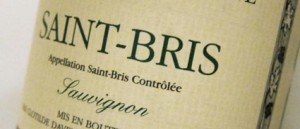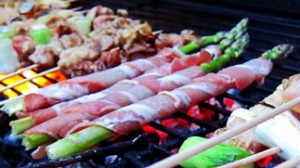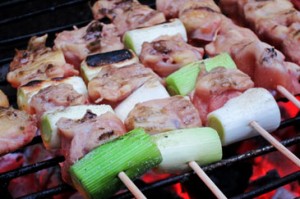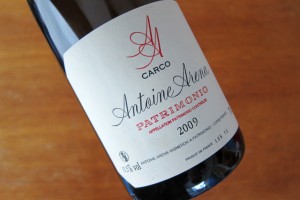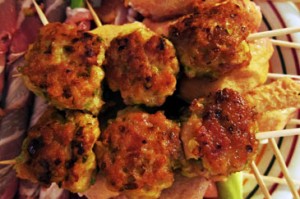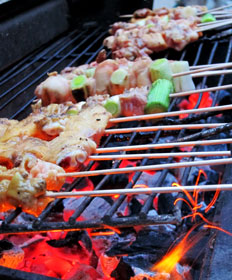 Barbecue weather calls for yakitori! On this pleasant evening, Mizuki prepared a variety of different chicken skewers to try with a few bottles of wine: a Saint-Bris Sauvignon Blanc and white Corsica from Patrimonio which we also tasted alongside tempura the next evening, but also a cheap local Languedoc rosé and red to get a first impression of how these colors work with the grilled chicken.
Barbecue weather calls for yakitori! On this pleasant evening, Mizuki prepared a variety of different chicken skewers to try with a few bottles of wine: a Saint-Bris Sauvignon Blanc and white Corsica from Patrimonio which we also tasted alongside tempura the next evening, but also a cheap local Languedoc rosé and red to get a first impression of how these colors work with the grilled chicken.
For each of the different skewers we only doused half in sweet the “tare” sauce, so that we could compare with the plain “shio” (ie. salt) version. I tend to prefer the latter, but tare does give the dish a more Japanese flavor, which is also quite nice.
So how did they wines fare with our special yakitori selection? Pretty well! Though there are some general rules which hinted at some of the successes to follow, a couple interesting pairings were unexpected, but there were some disappointments as well. Following is the break-down for each wine.
Saint-Bris Sauvignon Blanc
The lightest wine of the evening, this grassy Sauvignon Blanc from the Chablis area of Burgundy offered a couple surprises, and confirmed some expectations as well. Overall, I think this was the most exciting wine, though not necessarily the most versatile. In fact, it was too light for all the yakitori in tare sauce, and should be reserved for the plain shio versions.
That said, two of the absolute best pairings of the evening involved this wine. As expected, the asparagus wrapped in bacon was a perfect pairing, with the green notes of the wine blossoming into floral aromas with the asparagus, while the bright acidity cut through the bacon fat. Gorgeous!
What I expected less was the wonderful match with tebasaki, or chicken wings, and to a lesser degree, the kawa (chicken skin). Again, the lively acidity lightened up these rather fatty cuts of chicken, with the green notes subsiding a bit, so that they only appeared in the background, adding a layer of complexity.
I thought the Sauvignon would show better with the classic negima, chicken alternating with green onion. While it still worked well, I think a fuller Sauvignon would be more appropriate. Perhaps a wine from New Zealand or Chile, or even a ripe Pouilly-Fumé from the Loire Valley. An oaked version might offer an even better match. Next time, I’d like to try this with a Pessac-Léognan.
The Saint-Bris did not work well with plain chicken on its own however, coming off as a bit diluted, and while it wasn’t as bad with the tsukune, ground chicken meat, it was still overpowered. Finally, the liver was a disaster, with the strong liver taste coming to the front.
Corsican Vermentino White
Antoine Arena’s Vermentino from the French island of Corsica is a full-bodied white with little oak influence. With ripe fruit and honeyed notes, I expected this star southern white to do wonders with the chicken, and while it was indeed quite versatile, it didn’t offer much excitement either.
The wine matched the weight of the regular chicken and tebasaki wings, though it isn’t until I tried the tare sauce versions of these two yakitori, as well as the kawa chicken skin, that I was truly impressed. The sauce brought out more fruitiness in the wine and the whole just tasted better than either element alone. Very nice! Otherwise, the wine simply accompanied the various skewers without adding much else in terms of flavor. The only time this rich wine felt a bit eclipsed was with the Japanese negi geen onion, and the tsukune ground chicken, which was a bit overwhelming on the finish for the whites. I’m thinking that one requires a very aromatic white such as a Gewurztraminer or Viognier to make this particular yakitori work, but a fruity red may be the best option. Finally, the liver worked out pretty well, perhaps the best of the group.
Light Rosé
This light Languedoc rosé from the Mourvèdre grape variety is a vin de pays which I buy in 5l box for easy outdoor sipping. I figured that I’d give it a shot with the yakitori, but overall, it did not offer any great match, simply accompanying the food in some cases, while fading quickly for some of the more flavorful yakitori. I think rosé has its place, but it would have to be a fuller-bodied version.
Ripe Oaked Red
I also opened a cheap Faugères from the Languedoc area to see how a ripe oaked red would work with the chicken. I was surprised how well it worked with the plain chicken, with the oak completely elevating the char-grilled flavors. A wonderful match, and I think that oak is the way to go with whites as well. This wasn’t the case with all types of chicken, as the asparagus and negi green onion completely clashed with the wine.
While the tebasaki wings and tsukune ground chicken did not benefit much from the wine as plain shio skewers, the addition of sweet tare sauce completely changed the game. Where the red came off as a bit heavy before, the sauce’s sweetness matched that of the wine and brought the fruit out to the forefront, while the oak continued to play off of the grilled flavors. Definitely the way to go, although brighter fruit might be the answer for liver. I’d try an oaked Burgundy or Beaujolais next time.




